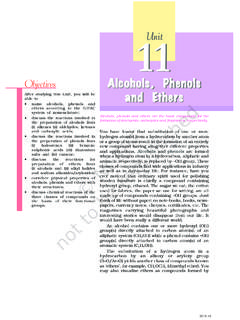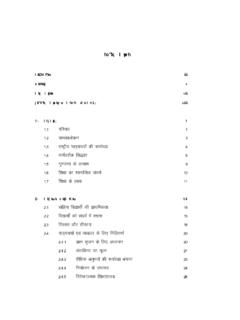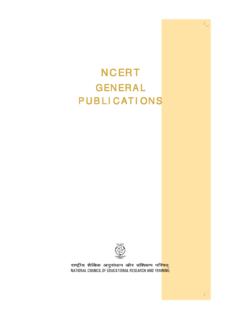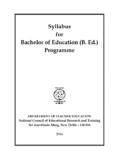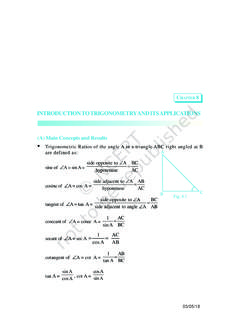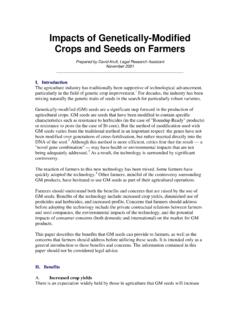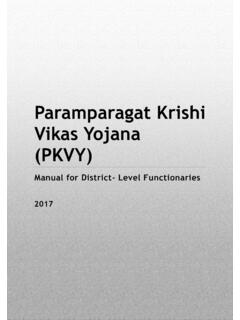Transcription of INFRASTRUCTURE - NCERT
1 After studying this chapter, the learners will understand the main challenges India faces in the areas of social andeconomic INFRASTRUCTURE know the role of INFRASTRUCTURE in economic development understand the role of energy as a critical component of INFRASTRUCTURE understand the problems and prospects of the energy and health sectors understand the health INFRASTRUCTURE of ECONOMIC INTRODUCTIONHave you ever thought of why somestates in India are performing muchbetter than others in certain areas? Whydo Punjab, Haryana and HimachalPradesh prosper in agriculture andhorticulture? Why are Maharashtraand Gujarat industrially moreadvanced than others? How comeKerala, popularly known as God s owncountry , has excelled in literacy, healthcare and sanitation and also attractstourists in such large numbers? Whydoes Karnataka s informationtechnology industry attracts worldattention?
2 It is all because these states havebetter INFRASTRUCTURE in the areas theyexcel than other states of India. Somehave better irrigation facilities. Othershave better transportation facilities, orare located near ports which makes rawmaterials required for variousmanufacturing industries easilyaccessible. Cities like Bengaluru inKarnataka attract many multinationalcompanies because they provideworld-class communication these support structures, whichfacilitate development of a country,constitute its INFRASTRUCTURE . Howthen does INFRASTRUCTURE facilitatedevelopment? WHAT IS INFRASTRUCTURE ? INFRASTRUCTURE provides supportingservices in the main areas of industrialand agricultural production, domesticand foreign trade and commerce. Theseservices include roads, railways, ports,airports, dams, power stations, oil andgas pipelines, telecommunicationfacilities, the country s educationalsystem including schools and colleges,health system including hospitals,sanitary system including cleandrinking water facili-ties and the monetarysystem includingbanks, insurance andother financial institu-tions.
3 Some of thesefacilities have a directimpact on productionof goods and serviceswhile others giveindirect support bybuilding the socialsector of the economy. Many things we need can wait, the child cannot. To him, we cannot say, tomorrow . His name is today. Gabrriella Mistral Chilean poetSo is the Roads are the missing link with growth2022-23141 INFRASTRUCUTRESome divide INFRASTRUCTURE intotwo categories economic and associated with energy,transportation and communicationare included in the former categorywhereas those related to education,health and housing are included inthe and large-scaletransport of seeds, pesticides , fertilisersand the produce usingmodern roadways,railways and shippingfacilities. In recent times,agriculture also dependson insurance andbanking facilitiesbecause of its need tooperate on a very contributes toeconomic development of a countryboth by increasing the productivity ofthe factors of production and improvingthe quality of life of its INFRASTRUCTURE can havemultiple adverse effects on in water supply andsanitation have a large impact byreducing morbidity (meaningproneness to fall ill) from majorwaterborne diseases and reducing theseverity of disease when it occurs.
4 Inaddition to the obvious linkage betweenwater and sanitation and health,the quality of transport andcommunication INFRASTRUCTURE canaffect access to health care. Air pollutionand safety hazards connected totransportation also affect morbidity,particularly in densely populated THE STATE OF INFRASTRUCTURE ININDIAT raditionally, the government has beensolely responsible for developing RELEVANCE OF INFRASTRUCTUREI nfrastructure is the support system onwhich depends the efficient working ofa modern industrial economy. Modernagriculture also largely depends on it forFig. Schools: an important INFRASTRUCTURE for a nationWork This Out In your locality or neighbourhoodyou might be using a variety ofinfrastructure. List all of locality may also berequiring a few more. List thoseseparately. Classify them usinga few criteria and discuss thedetails in the ECONOMIC DEVELOPMENT country s INFRASTRUCTURE .
5 But it wasfound that the government s investmentin INFRASTRUCTURE was , the private sector by itself andalso in joint partnership with the publicsector, has started playing a veryimportant role in majority of our people livein rural areas. Despite so muchtechnical progress in the world,rural women arestill using bio-fuelssuch as cropresidues, dungand fuel wood tomeet their energyrequirement. Theywalk long dis-tances to fetchfuel, water andother basic census 2011shows that in ruralIndia only 56 percent householdshave an electricityconnection and 43per cent still usekerosene. About85 per cent of therural householdsuse bio-fuels forcooking. Tap wateravailability islimited to only 31per cent ruralhouseholds. About69 per cent of thepopulation drinkswater from opensources such as wells, tanks, ponds,lakes, rivers, canals, etc.
6 Access toimproved sanitation in rural areas wasonly 30 per at Table which shows thestate of some INFRASTRUCTURE in India incomparison to a few other it is widely understood thatinfrastructure is the foundation ofdevelopment, India is yet to wake upto the call. India invests only 30 per centFig. Dams: temples of developmentFig. Safe drinking water with pucca house: still a dream2022-23143 INFRASTRUCUTREof its GDP on INFRASTRUCTURE , which isfar below that of China and economists have projectedthat India will become the third biggesteconomy in the world a few decadesfrom now. For that to happen, India willhave to boost its infrastructureinvestment. In any country, as theincome rises, the composition ofinfrastructure requirements changessignificantly. For low-income countries,basic INFRASTRUCTURE services, likeirrigation, transport and power, aremore important. As economies matureand most of their basic consumptiondemands are met, the share ofagriculture in the economy shrinks andmore service-related INFRASTRUCTURE isrequired.
7 This is why, the share of powerand telecommunication infrastructureis greater in high-income , development of infrastructureand economic development go hand inhand. Agriculture depends, to aconsiderable extent, on the adequateexpansion and development of irrigationfacilities. Industrial progress dependson the development of power andelectricity generation, transport andcommunications. Obviously, if properattention is not paid to the developmentof INFRASTRUCTURE , it is likely to act as aTABLE INFRASTRUCTURE in India and other Countries, 2018 CountryInvestment* in Percentage of people usingMobileConsumptionInfrastructure safely managedSubscribers/100of energy ( a % GDP DrinkingSanitationPeopletonnes of Water SourcesServicesoil equivalent)China4496721153274 Hong Kong221009225931 India 30944087809 South Korea3198100130301 Pakistan1635647385 Singapore2810010014688 Indonesia348761120186 Sources: World Development Indicators 2019, World Bank website.
8 BP Statistical Review of World Energy 2019, 69th : (*) refers to Gross Capital These Out While reading newspapersyou will come across termslike Bharat Nirman, SpecialPurpose Vehicle (SPV),Special Economic Zones(SEZ), Build OperateTransfer (BOT), PrivatePublic Partnership (PPP) a scrapbook of newsitems containing theseterms. How are these termsrelated to INFRASTRUCTURE ? Using the references atthe end of the chapter,collect the details ofother ECONOMIC DEVELOPMENT severe constraint oneconomic development. Inthis chapter the focuswill be on only two kinds ofinfrastructure thoseassociated with energyand ENERGYWhy do we need energy?In what forms is itavailable? Energy is acritical aspect of thedevelopment process of anation. It is, of course,essential for it is used on a largescale in agriculture and related areaslike production and transportation offertilisers, pesticides and farmequipment.
9 It is required in houses forcooking, household lighting andheating. Can you think of producing acommodity or service without usingenergy?Sources of Energy: There arecommercial and non-commercialsources of energy. Commercialsources are coal, petroleum andelectricity as they are bought andsold. Non-commercial sources ofenergy are fuelwood, agriculturalwaste and dried dung. These are non-commercial as they are notavailable in the market on alarge commercialsources of energy aregenerally exhaustible (withthe exception of hydropower),non-commercial sources ortraditional are generallyrenewable. More than 60 percent of Indian householdsdepend on traditionalsources of energy formeeting their regularcooking and heating Bullock carts still play a crucial role in ruraltransportation marketFig. Fuel wood is the major source of energy2022-23145 INFRASTRUCUTRENon- conventional Sources ofEnergy: Both commercial andnon-commercial sources ofenergy are known asconventional sources of are three other sourcesof energy which are commonlytermed as non-conventionalsources solar energy, windenergy and tidal power.
10 Beinga tropical country, India hasalmost unlimited potential forproducing all three types ofenergy if some appropriate cost effectivetechnologies are used. Even cheapertechnologies can be Pattern of CommercialEnergy: In India, commercial energyconsumption makes up about 74 percent of the total energy consumed inIndia. This includes coal and lignitewith the largest share of 74 per cent,followed by oil at 10 per cent, naturalgas at 9 per cent, hydro and other newand renewable energy at 7 per energy sourcesconsisting of firewood, cow dung andagricultural wastes account for over 26per cent of the total energyconsumption. The critical feature ofIndia s energy sector, and its linkagesto the economy, is the importdependence on crude and petroleumproducts, which is likely to grow rapidlyin the near sectoral pattern of consumptionof commercial energy is given in The transport sector was the largestconsumer of commercial energy in1953-54.
